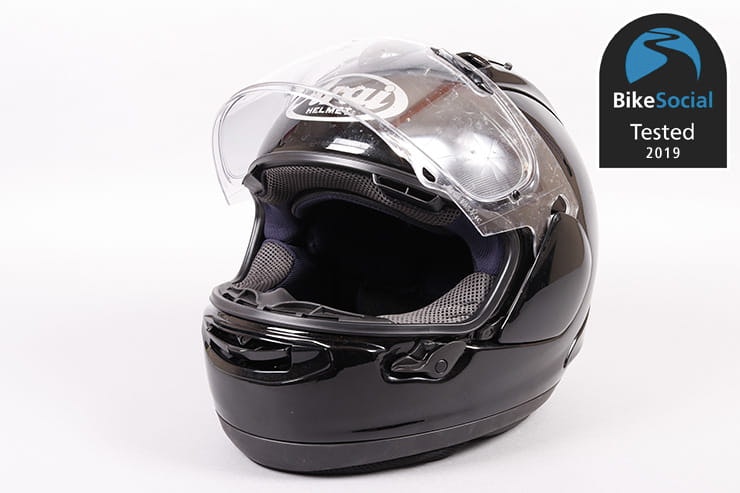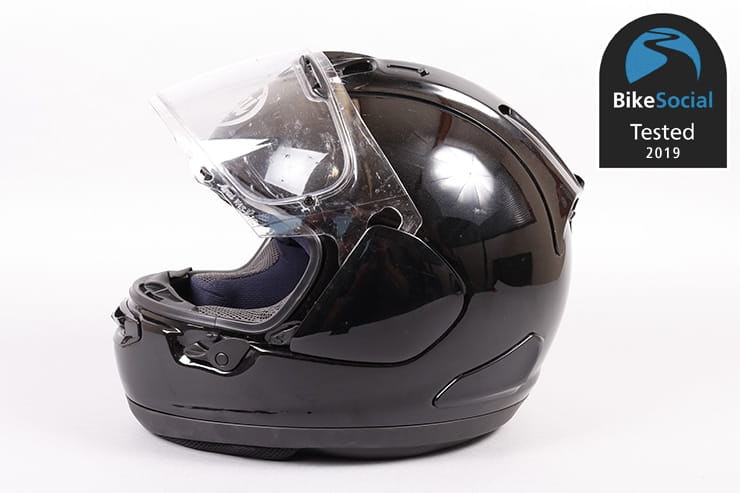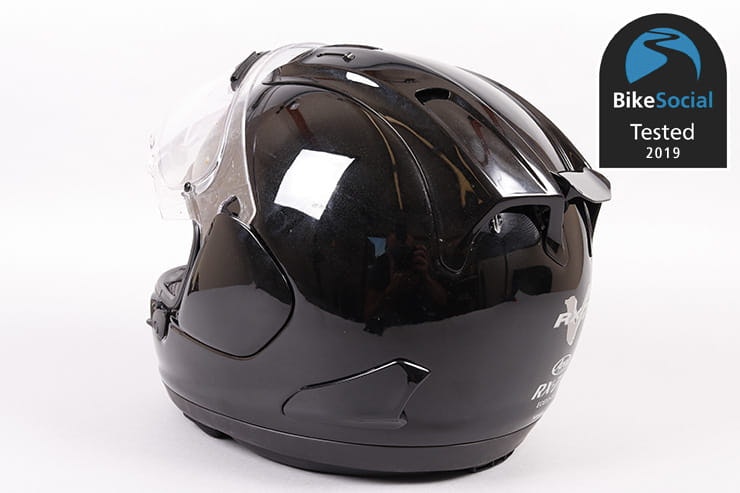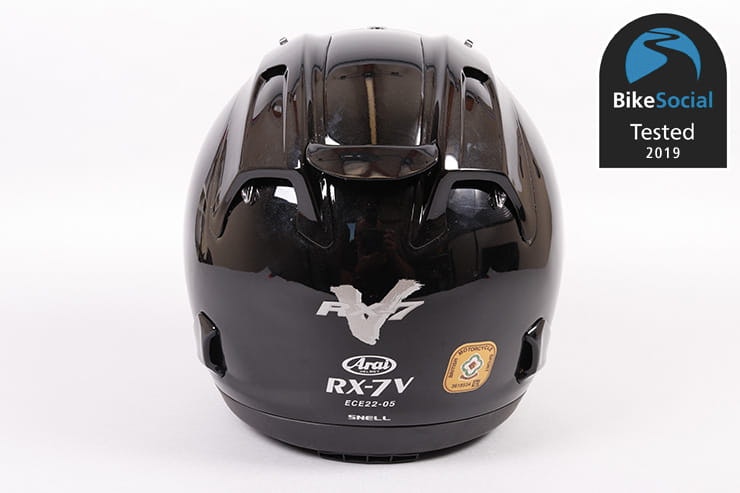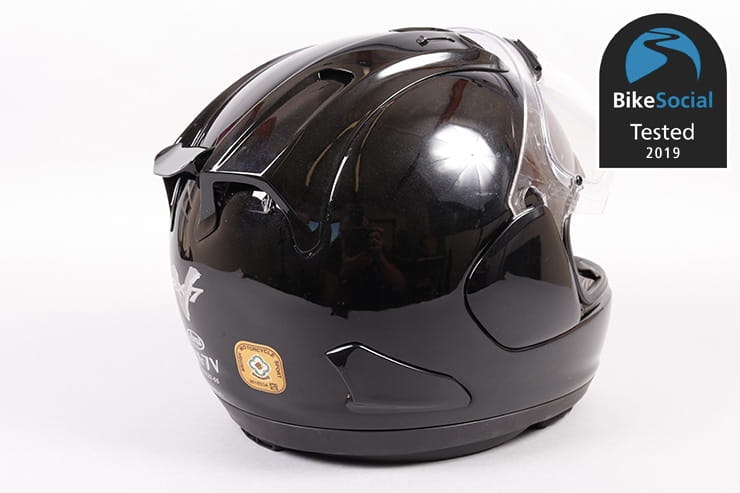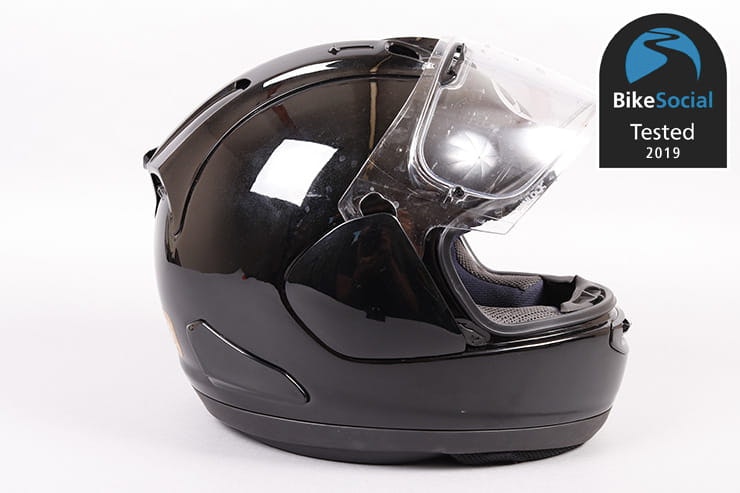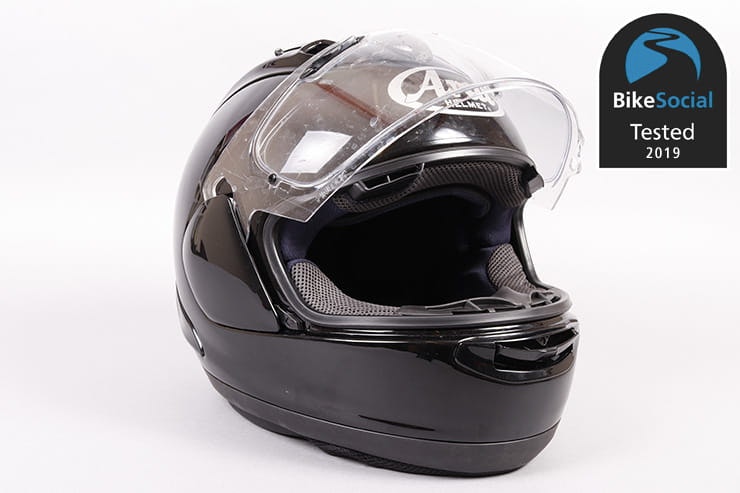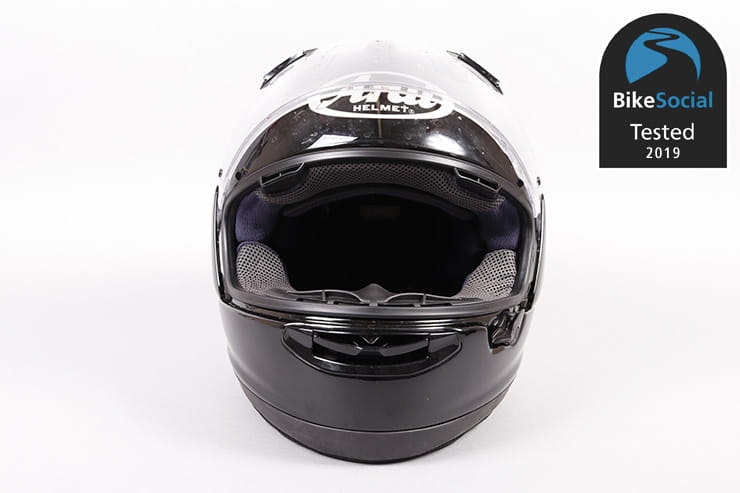Tested: Arai RX-7V motorcycle helmet review
By John Milbank
Consumer Editor of Bennetts BikeSocial
28.10.2019
Date reviewed: October 2019 | Tested by: John Milbank | Price: From £669.99 | www.whyarai.co.uk
PLEASE NOTE: AS OF 2023, THIS REVIEW IS OF THE PREVIOUS GENERATION RX-7V. TO READ THE REVIEW OF THE NEW ARAI RX-7V EVO, CLICK HERE.
The Arai RX-7V on review here is the top-of the range motorcycle helmet from the Japanese company. First released in 1996 (with a lineage going back to 1968), the RX-7 has long been the flagship model – it’s had a reputation for being noisy thanks to its aggressive air ducting, and the brand as a whole has become known for producing what appear to be relatively heavy lids. Is that true?
I’ve been wearing this one for over 1,000 miles on a variety of bikes to find out why, despite there being cheaper options in the range (and of course from other brands), the RX-7 continues to be Arai’s best-selling helmet…
Outer shell
This handmade lid uses Arai’s premium construction methods; the shell has its top-end PB-SNC2 build – that’s Peripherally Belted Structural Net Composite. Basically, the Peripheral Belt means the shell is strengthened across the top of the visor aperture to make for a stronger outer without having to increase the thickness of the inner EPS (expanded polystyrene); this is important in a helmet that’s so popular with racers because it prevents the brow from getting too thick, which restricts vision when you’re tucked down on the tank.
The Structural Net Composite relates to the overall shell construction of multiple fibres and resin. Arai says that its latest method makes for a thinner and lighter shell compared to previous models.
On the left is what the bare, undrilled shell of an RX-7 looks like…
The smooth outer shell is designed to glance off in an impact – in a similar way that MIPS is claimed to reduce the torsional forces transferred to the brain in an impact, an Arai’s profile is said to glide over tarmac, rather than grabbing, meaning your head is less likely to get whipped about in a crash. The vents on all Arais (including the large ports here on the RX-7) are designed to break off in a crash, leaving that smooth shell to slide unhindered.
This is the cheapest base-model of RX-7V, available in gloss black, gloss white or matt black. Here in gloss black it has a fine metal flake under the lacquer, with the overall finish (as you’d expect) being excellent. The paint appears to be slightly more prone to chipping than some others, with a couple of tiny chips evident on the chin section.
£789.99 gets you graphics from current riders like Jonathan Rea and Leon Haslam, to classics like Freddie Spencer and Mick Doohan reps. A Honda CB and two IoM TT models push the price up to £875, while a carbon fibre model is also available at an eye-watering £2,799.99.
Weight
Arai firmly believes that by using a very strong outer shell with a softer, multi-density single-piece EPS inner makes for the safest helmet possible. It’s of course certified to ECE22.05, as well as carrying SNELL approval (and an ACU Gold sticker), but it also has a SHARP five star rating.
Every manufacturer will of course claim that its design is the safest, but real-world accidents are obviously impossible to repeat and measure. The idea of a very hard outer and soft inner appeals to me, and I’ve worn Arais on and off since the first lid I bought in 1996. But there’s no denying that – on first impressions – the brand seems weighty compared to some others.
At 1672g, this medium RX-7 is 322g heavier than a small Shoei GT Air II, 86g heavier than the Arai Profil in medium and 413g heavier than the carbon-fibre Scorpion EXO-1400.
Pick it up after the others and you’ll feel it’s got more mass, but on the head it’s just not noticeable. To be honest, over the past twenty or so years of wearing various motorcycle helmets, there have only been a few that felt fatiguing to wear, and that’s been more down to drag in the wind or poor balance in the design. This isn’t one of them.
Ventilation
The most obvious feature of the RX-7 series has long been the distinctive air scoops running across the top; there are three intakes on the top of the lid, each with a two-position and closed slider that’s easy to operate and very positive in its action.
On the rear, hidden under those scoops, are four exhaust ports that also have a two-position and closed lever, though the action of this is less positive if you’re trying to find the halfway point while riding. Fully open and closed though it’s fine, and I’ve never felt the need to look for something in between.
There’s also a pair of always-open exhausts on the lower rear of the shell, and while the spoiler at the top of the rear is adjustable through five positions ‘to reduce drag, turbulence and buffeting resulting in more comfort and additional top speed’, I can’t tell the difference; it’s probably more relevant to a MotoGP rider at full chat…
While the EPS lining has no channels cut into it, the fabric liner creates space for a huge amount of airflow. This isn’t a lid that blasts your head at one obvious point, rather plenty of air is able to flow along the top, then is efficiently sucked away by the six exhaust ports. The only disadvantage here is that, as with many other lids, it is possible for a good-sized fly to get inside when the vents are wide open. Like a proton torpedo finding its Death Star exhaust port, I had a horsefly blast straight into the top on one side, as well as a wasp a few weeks later – you probably know the tickling feeling and the frantic rubbing to try to stop a fly or worse before you can pull in. This is certainly not something unique to Arai – I’ve had it happen on a Shoei too – but with the top vents of the RX-7V set to half open, I still get plenty of ventilation. Those bigger bugs don’t seem to hit their target any more.
The front features an easy to use two-position and off chin vent that blows up onto the visor through a removable nose spoiler, and also onto your mouth. A charcoal foam filter in here helps clean the polluted air and also filter flying debris like bugs and grit – it’s a little-known fact that Arai started using this after Mick Doohan had a bee get in through the chin vent while racing on a track.
On the visor are a pair of two-position and closed vents that, when open, allow air to be blown onto your brow. These are pretty easy to open and close with your gloves on, but they are fiddly to get half-way; I leave them open for most riding.
None of the ducts and ports are cosmetic – all have clear routes into and out of the interior – so with a total of 12 inlets and exhausts, the Arai is an incredibly airy helmet when everything’s opened up, without any obvious cold spots.
Even with all the vents shut, if you’re on a naked or sports bike the RX-7V still feels a little airy – it appears a small draft can get in around the vents built into the visor. This is a sports lid, so while riding a naked in the winter would be colder than a helmet that completely seals, it’s not really what it’s designed for. If you’re sat behind a large screen you’ll of course not notice any draft.
Visor
If you’ve not removed an Arai visor before (and not read the instructions), you might be under the impression that it’s a fragile, awkward design.
Arai was the first helmet manufacturer to introduce a tool-less visor (in 1988), and over the years it’s evolved. For a long time, the visor was removed by pulling apart the rear of the plastic shield and rotating it up and out; simple and extremely quick (I could change an Arai visor while wearing the lid). But it was fairly brutal, and many owners worried they might break something. Of course, the visor is almost indestructible – it can be bent back on itself – but after several years of use the side covers did have a habit of becoming brittle, the clips breaking and then falling off. Particularly bad as this meant the visor wasn’t secure when you opened it up.
Even in the previous iteration, which saw small levers helping to push the visor outwards for removal so reducing the force required, the visor wasn’t fully retained if the side cover broke off.
Now it’s been completely redesigned – pressing the little levers pops the covers off before the visor is rotated out. Popping it back in is just as quick (as long as you read the instructions), and with this new system, even if the sidepod did break off, the visor would still be secure.
How to remove an Arai visor
A quick demonstration of how Arai’s new and previous visor mechanisms work
The visor seals perfectly, not allowing any water in along the top edge, and the field of view is very good. The aperture is set slightly higher than, say, a touring lid as it needs to give a good view when you’re hunched over a sportsbike tank, but having ridden with it on a BMW S1000XR and a Kawasaki Versys 1000, there’s nothing wrong with it on a tourer. At most, you’ll notice that looking down at your chest or waist pockets is harder in a sports-focussed helmet like this, though that high and narrow brow also means you can’t tip your head to block low sun. And there’s no drop-down sunshield.
Part of Arai’s conviction in the way it makes helmets is that it doesn’t want to compromise the integrity of its shells with the mechanism for a sunshield; it also doesn’t want that gap between the outer and inner shell. Personally, I prefer to use a dark visor, carrying my clear just in case; a drop-down shield adds an extra layer of plastic to reduce clarity and always leaves a light band at the bottom that I find distracting. But a dark visor costs an extra £60. Another option is the Arai ProShield – a flip-up dark visor that attaches to the outside, but it costs £100.
A Pinlock Max Vision 120 is supplied – the highest performing anti-fog insert – and I’ve had no fogging issues. As a spectacle wearer though, my glasses always fog long before the visor.
The visor is ‘infinitely adjustable’ – that means there are no set ratchet positions; instead you can open the visor and leave it wherever you want (wind blast permitting). I like this smooth action over a ratchet, though being a fairly thin shield it can shake when it’s open if you’re on a bike with a buffeting screen – annoying when there are flies stuck to the front.
My real criticism with the Arai visor is that the latch on the left is awkward to use. I prefer to have a central thumb operation (or a ledge at either side) that makes it easier to pop the visor open when I’m sat at traffic lights holding the clutch in with my left hand.
Arai has designed its shield in such a way that it locks securely down – there’s no chance of it flicking open at high speed – but that can also make it trickier to open. It’s easy to set at a cracked position, and the new lever that unlocks it is (in principle) very simple. But in practice there are times that it just doesn’t seem to want to release – catch it at the wrong angle as you quickly try to flick it open when approaching a junction and it can be frustratingly stubborn. The trick is to ensure your thumb gets under the lip of the shield as you rotate the lever upwards – get it wrong and you’re pushing it back onto the catch. There’s a knack.
Lining
The RX-7V’s lining is fully removable (and replaceable) – the cheek pads, skull cap, chin skirt, neck roll and fastener strap covers all come out and can be cleaned with mild soap by hand. I always wash helmet linings with them in the helmet bag then pop them in the washing machine on a hand wash setting, but I do it at my own risk.
Read the manual and the lining is fairly quick and easy to remove and refit so over years of ownership, keeping it clean and fresh won’t be much of a chore.
The chin skirt is removable for increased air flow, and underneath is an adjustable spoiler that can be pulled down to deflect wind a little more from beneath your chin.
The cheek pads have quick-release tabs fitted – they’re tucked right out of the way but can easily be pulled out a little to be more obvious to emergency responders. Pulling them fully drags the cheek pads out even with the helmet fitted, so if the worst did happen, the lid can be taken from the head with minimal stress on the neck.
Fastening
The RX-7V uses the racer’s choice of a double-D fastener – it’s not something you can do up with gloves on, but it’s always secure.
Fit
Always try a helmet on before you buy, checking for pressure points as well as a good snug fit. The RX-7V comes with ‘peel away’ sections of foam on the liner at the temple, cheek pads and ears (to help fit intercom speakers); these are 5mm thick when uncompressed, and I didn’t feel the need to remove any for a good fit. I typically take a medium, and this Arai was utterly comfortable straight out of the box; it’s a lid I can wear all day without any problems.
My glasses fit under the helmet without any issues, not feeling pressed against my head or floating above my nose.
Noise
The RX-7V is not noticeably noisier than any other similar helmet. Like any lid, you need to wear earplugs, and equally, the noise levels will depend on the fairing and screen of the bike. BikeSocial’s Michael Mann commented that, compared to his AGV Pista GP, there was more of a rushing air sound – like a vent was open.
The Arai isn’t the quietest helmet available when riding a naked or sports bike with a low-screen, but once you’re behind a screen it becomes mostly irrelevant – buffeting is the biggest cause of noise.
For more information on why earplugs are vital with any helmet, and advice on which are the best, click here.
Conclusion
Arai has always been a premium brand and despite this being the cheapest version of the RX-7, it’s still a substantial investment.
But that expense (about £2.50 per week over the five year warranty period), does get you some top-end features; a multi-density soft inner shell, an exceptionally strong outer, fully removable and washable lining and superb ventilation.
The lack of a drop-down sunshield will annoy some people, but it’s the sometimes irritating visor catch that’s the only flaw for me in this otherwise excellent helmet.
Forget about the idea of this being heavy – what matters is how it feels on the head, so if it fits you well, and you can afford it, besides a couple of gripes it’s an outstandingly high-quality lid that inspires the utmost confidence.
Why are some lids more expensive than others?
We cut three helmets apart to find out where your money goes…
